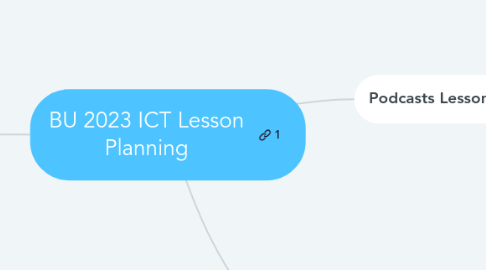
1. Maps lesson plan
1.1. Objectives
1.1.1. From Manitoba Curriculum
1.1.1.1. General learning objective
1.1.1.1.1. Specific Learning Objective
1.1.2. Bloom's Taxonomy l
1.1.2.1. Hess's Cognitive Rigor Matrix
1.1.2.2. Webb's Depth of Knowledge Chart
1.1.3. From ICT Continuum
1.1.3.1. Cognitive Objective
1.1.3.1.1. G-3.2 assesses textual, numerical, aural, and visual information, as well as the sources of the media, to determine context, perspective, bias, and/or motive View student friendly version I think critically about the information I find, and about its source, to determine if it might be biased in any way.
1.1.3.2. Affective Objective
1.1.3.2.1. Health and Safety Guidelines and
1.1.3.2.2. The Ethics and Responsibility Guidelines.
1.1.4. Pscyomotor Domain
1.1.4.1. Not as frequently discussed but should not be neglected particularly when designing lessons that have any components of physical activity
1.2. Prerequisites
1.2.1. Review
1.2.1.1. Lower level Bloom's taxonomy.
1.2.2. Goals
1.2.2.1. try to connect to learners' intrinsic motivatons
1.2.3. Set context
1.2.3.1. Gain attention
1.2.3.1.1. Plant the hook
1.2.4. Ask a question
1.2.4.1. How does your mobile phone know where it is?
1.2.4.1.1. GPS
1.3. Resources
1.3.1. Materials
1.3.1.1. web links
1.3.1.2. applications
1.3.1.3. data sources
1.3.2. Facilities
1.3.2.1. IT group onside?
1.3.2.2. Any blocks that need lifting?
1.3.3. People
1.3.3.1. permissions
1.3.3.1.1. Parental
1.3.3.1.2. division
1.3.3.1.3. Copyright?
1.3.3.2. Is someone else involved?
1.3.3.2.1. interviewees
1.4. Notes
1.4.1. Lesson or Series Title
1.4.1.1. Cluster
1.4.2. Goals of Each Lesson
1.4.3. Objectives
1.4.4. Reasoning
1.4.5. Content
1.4.6. Method of Instruction
1.4.6.1. Activate
1.4.6.2. Aquire
1.4.6.3. Apply
1.4.6.4. Adapt
1.4.7. Method of Evaluation
1.4.7.1. Teaching Learning and Assessment Strategies.
1.4.7.2. Rubrics
1.4.7.2.1. Kinds
1.4.7.2.2. Purposes
2. Podcasts Lesson Plan
2.1. Objectives
2.1.1. From ICT Continuum
2.1.1.1. Cognitive Objective
2.1.1.1.1. G-3.2 assesses textual, numerical, aural, and visual information, as well as the sources of the media, to determine context, perspective, bias, and/or motive
2.1.1.2. Affective Objective
2.1.1.2.1. weighs society’s right to information access against right to individual privacy
2.1.2. From Manitoba Curriculum
2.1.2.1. Grade 12 Global Issues: Citizenship and Sustainability (40S) Course Code: 1128
2.1.2.1.1. General learning objective
2.1.2.1.2. Citizenship as a Core Concept
2.1.3. Bloom's Taxonomy l
2.1.3.1. Hess's Cognitive Matrix
2.1.3.2. Webb's Depth of Knowledge Chart
2.1.3.3. Bloom's in a digital environment
2.2. Prerequisites
2.2.1. Review
2.2.1.1. Review basic ICT skills
2.2.1.1.1. How to use applications
2.2.1.1.2. How to save a file
2.2.1.1.3. How to connect a microphone and adjust volume
2.2.1.1.4. How to upload and download files
2.2.1.1.5. How to embed things on a web page
2.2.1.2. Reminder of where you have been and where you are going with this lesson
2.2.1.2.1. Last week we examined UNESCOs Four Pillars of Learning
2.2.1.2.2. this lesson we will focus on the four the pillar
2.2.1.2.3. next week we will
2.2.2. Goals
2.2.2.1. Reminder of what you expect accomplish
2.2.2.1.1. Learners need to consider how their worldview is shaped and think critically about the many factors that influence their decisions and actions.
2.2.3. Introduction/Set
2.2.3.1. A society that doesn't learn from history is doomed to repeat its failures.
2.2.3.2. We live in a global village
2.2.3.3. Start with a question
2.2.3.3.1. What consequences of not learn from this?
2.2.3.4. BU Lesson Plan templates
2.2.3.4.1. Activate
2.2.3.4.2. Aquire
2.2.3.4.3. Apply
2.3. Resources
2.3.1. Materials
2.3.1.1. multimedia computer
2.3.1.1.1. audio files
2.3.2. People
2.3.2.1. Someone who has recently become a Canadian citizen
2.3.2.1.1. Record a conversation with a someone who has recently become a Canadian citizen.
2.3.2.2. Someone who was a citizen of another country but came to Canada long ago
2.3.2.3. Accommodations
2.3.2.3.1. Permissions
2.3.3. Facilities
2.3.3.1. Computer lab
2.3.3.1.1. Coffee shop
2.3.3.2. Skype account
2.3.3.2.1. Twitter account
2.4. Notes
2.4.1. Lesson or Series Title
2.4.2. Goals of Each Lesson
2.4.3. Objectives
2.4.4. Analysis
2.4.4.1. Reasoning
2.4.4.1.1. Why was this format chosen to support this lesson
2.4.5. Content
2.4.6. Method of Instruction
2.4.6.1. Direct Instruction
2.4.6.1.1. Stand and Deliver
2.4.6.2. Guided Practice
2.4.6.3. Independent Practice
2.4.6.4. Flipped classroom
2.4.6.4.1. Khan Academy
2.4.7. Method of Evaluation
2.4.7.1. Demonstration project
2.4.7.1.1. Can they do it
2.4.7.1.2. Can they do it well
2.4.7.1.3. Can it be used by professional teachers
2.4.7.2. Assessment
2.4.7.2.1. for
2.4.7.2.2. of
2.4.7.2.3. as
2.4.8. Accommodations
2.4.8.1. Permissions
2.4.9. Summary
2.4.9.1. Review
2.4.9.1.1. What worked?
2.4.9.1.2. What didn't work
2.4.9.1.3. What is needed for next time?
2.4.9.1.4. What needs to be changed?
3. Videocast Lesson Plan
3.1. Objectives
3.1.1. From ICT Continuum
3.1.1.1. Cognitive Objective
3.1.1.2. Affective Objective
3.1.2. From Manitoba Curriculum
3.1.2.1. General learning objective
3.1.2.1.1. Specific Learning Objective
3.1.3. Bloom's Taxonomy l
3.1.3.1. Hess's Cognitive Matrix
3.1.3.2. Webb's Depth of Knowledge Chart
3.2. Prerequisites
3.2.1. Review
3.2.2. Goals
3.2.3. Set context
3.3. Resources
3.3.1. Materials
3.3.2. People
3.3.3. Facilities
3.3.4. Platforms
3.3.4.1. TikTok
3.3.4.2. YouTube
3.3.4.3. TeacherTube
3.4. Notes
3.4.1. Lesson or Series Title
3.4.2. Goals of Each Lesson
3.4.3. Objectives
3.4.4. Reasoning
3.4.5. Content
3.4.6. Method of Instruction
3.4.6.1. High tech, teacher centered
3.4.6.1.1. Flipped classroom
3.4.6.1.2. Smart boards
3.4.6.2. High tech, student centered
3.4.6.2.1. Web quests
3.4.6.2.2. Personal Learning environments
3.4.6.3. Low Tech, teacher centered
3.4.6.3.1. Direct instruction
3.4.6.3.2. Kinesthetic learning
3.4.6.4. Low tech, student centered
3.4.6.4.1. Differentiated instruction
3.4.6.4.2. Expeditionary learning
3.4.7. Method of Evaluation
